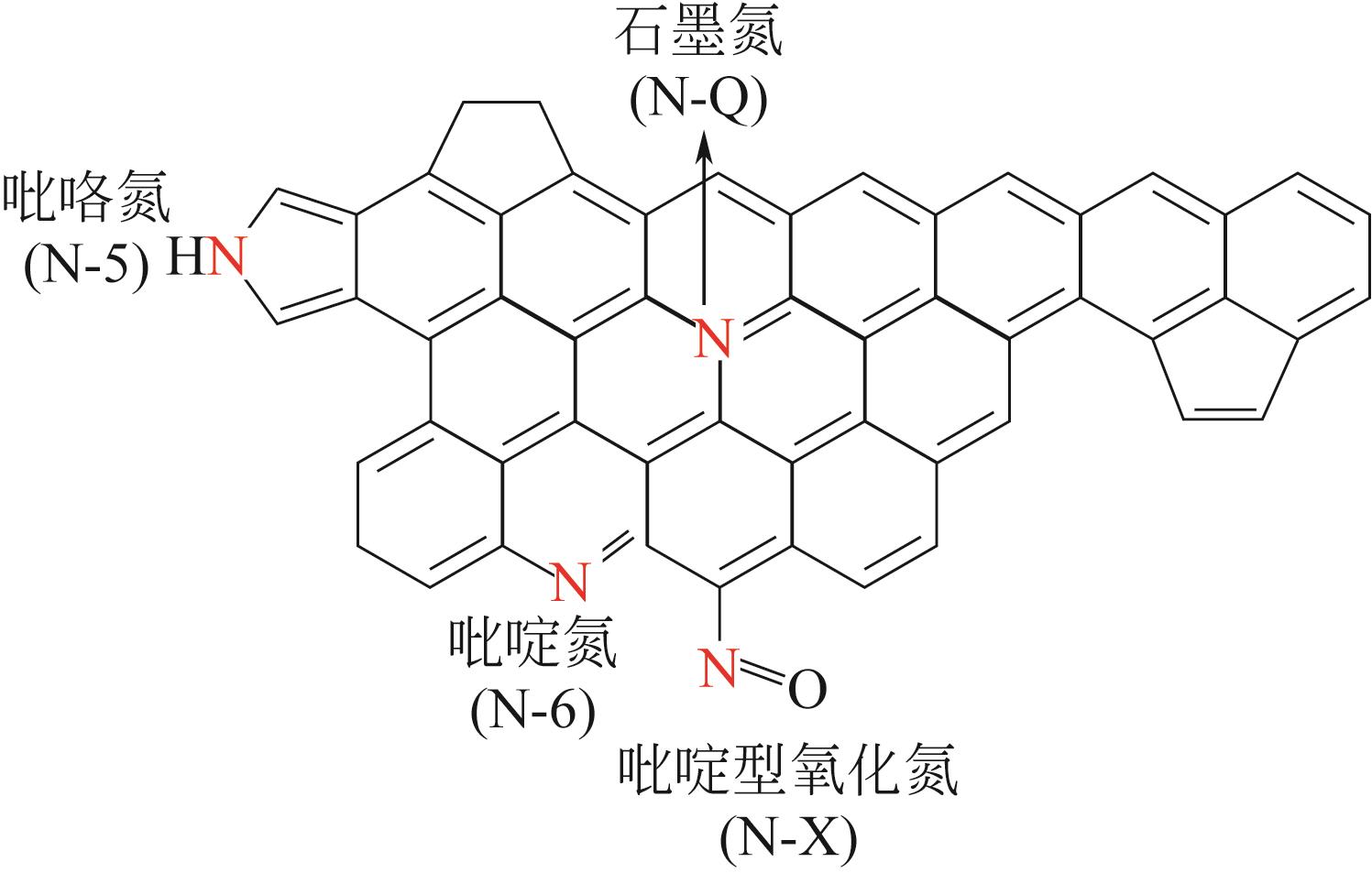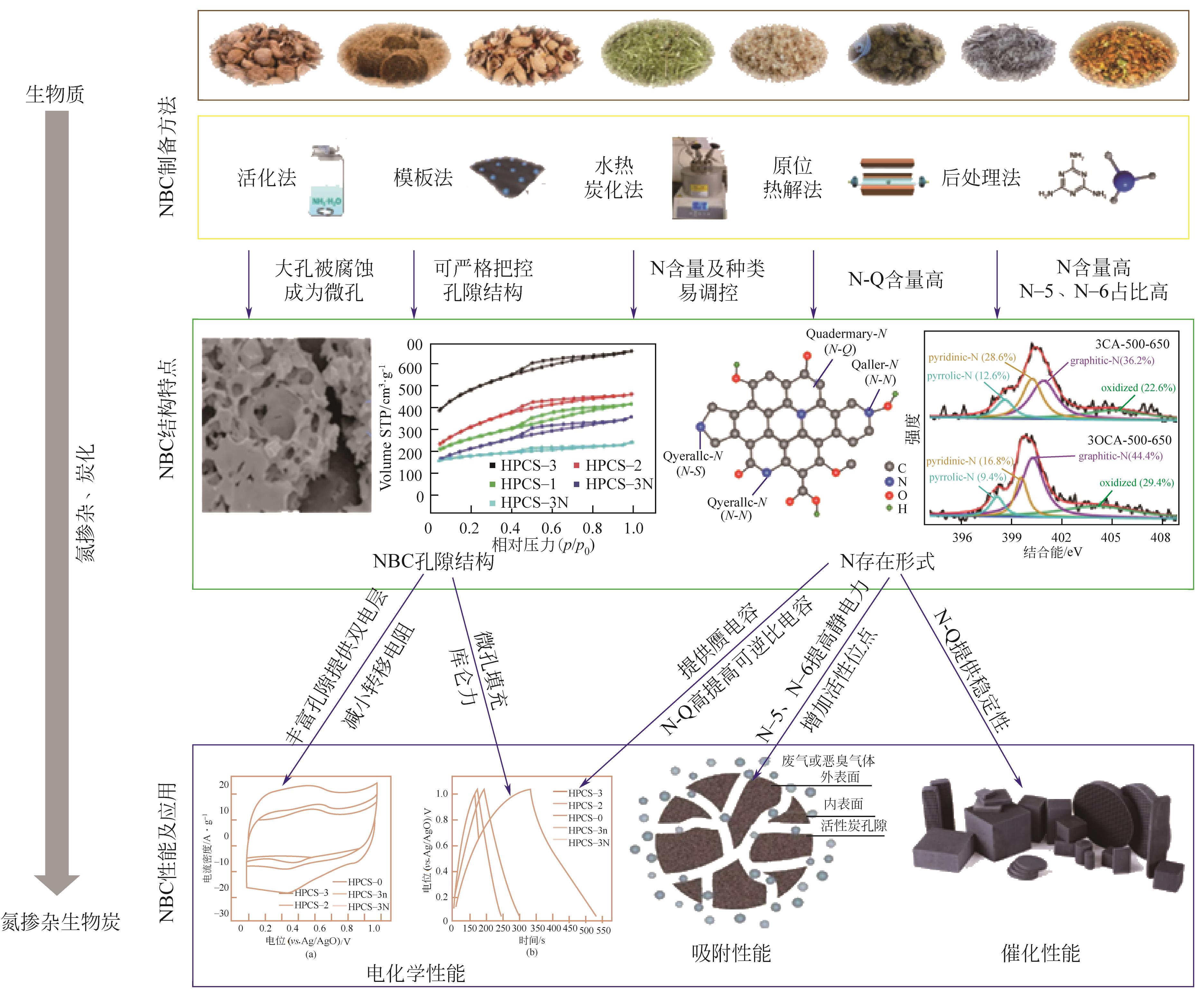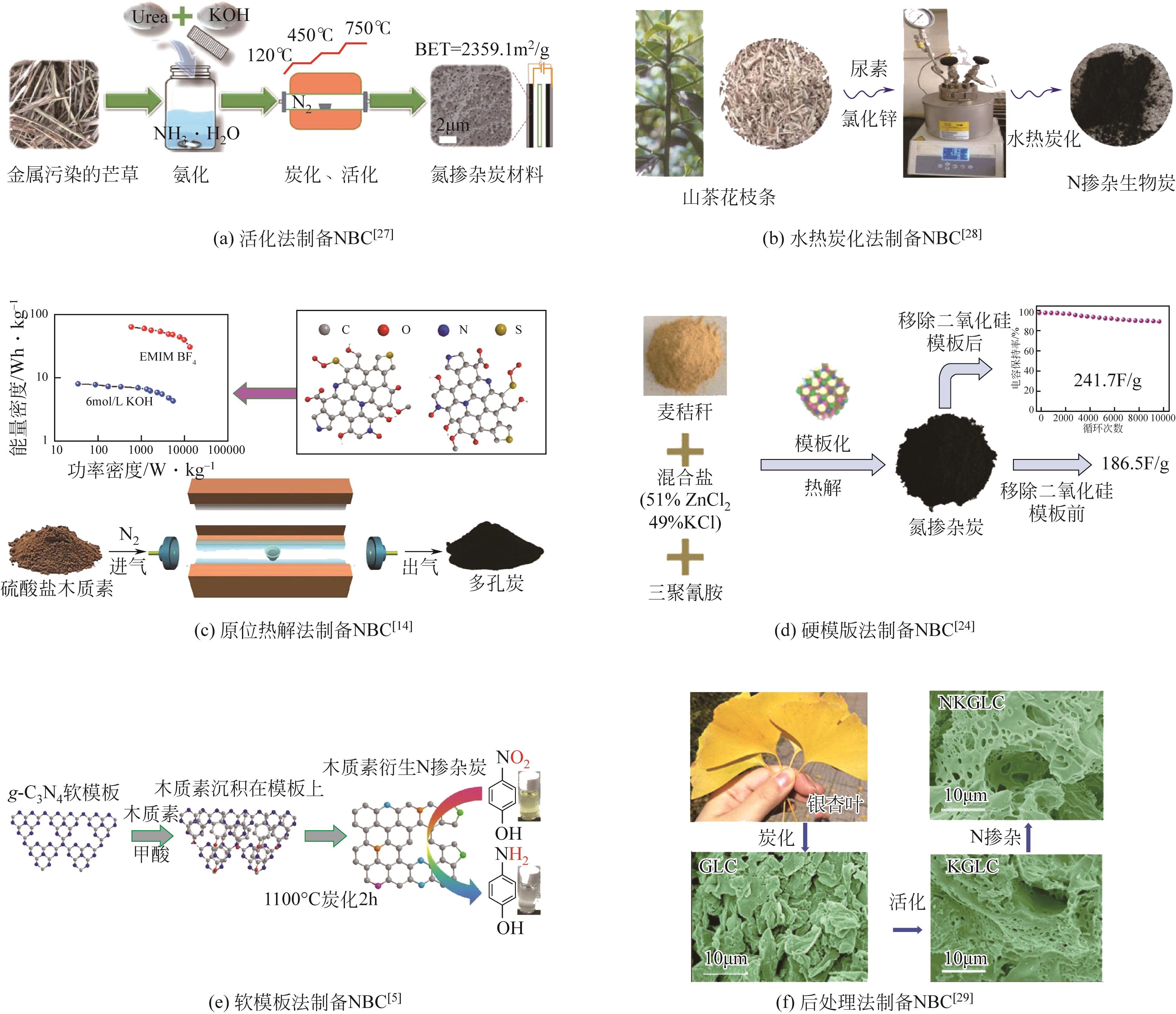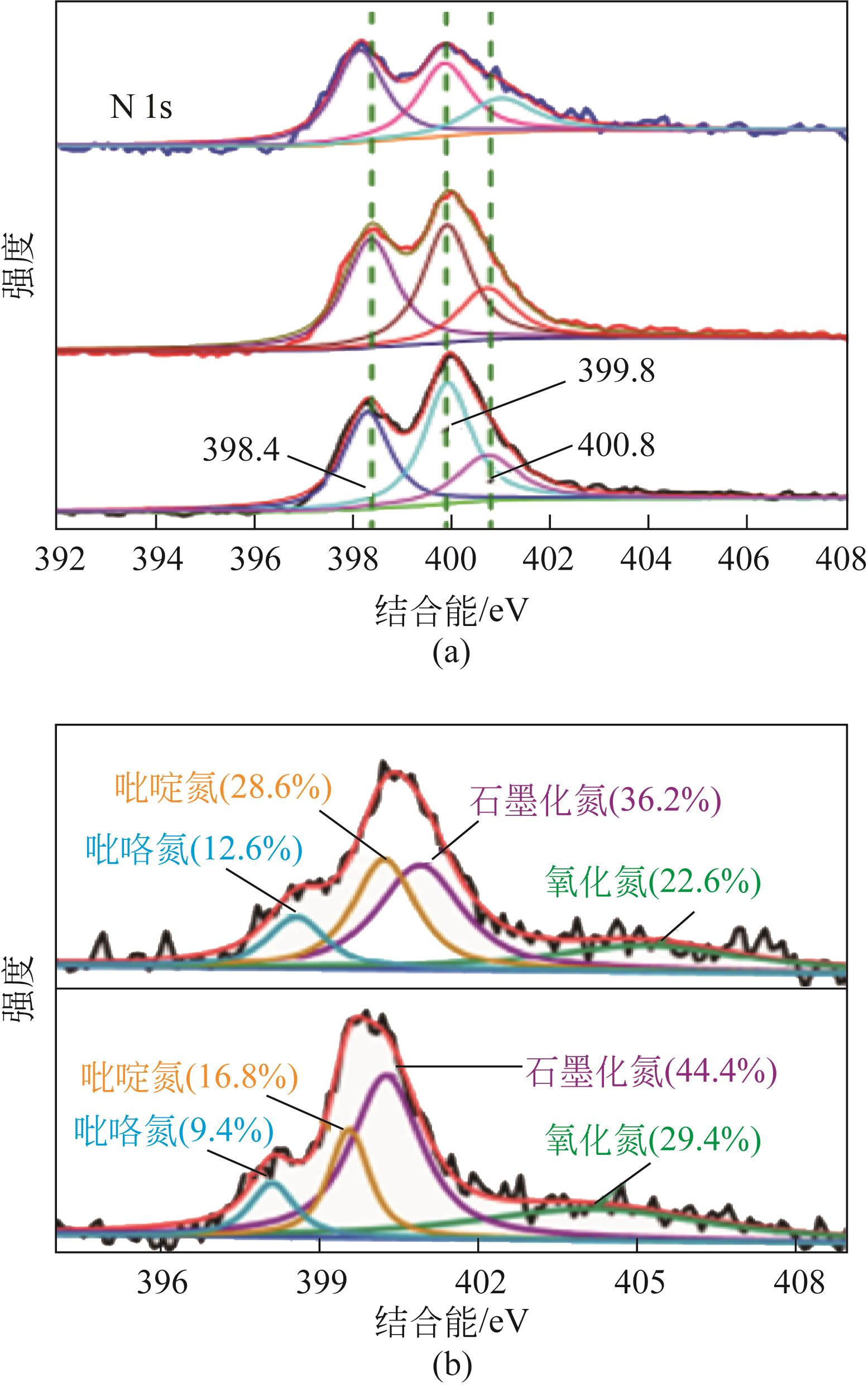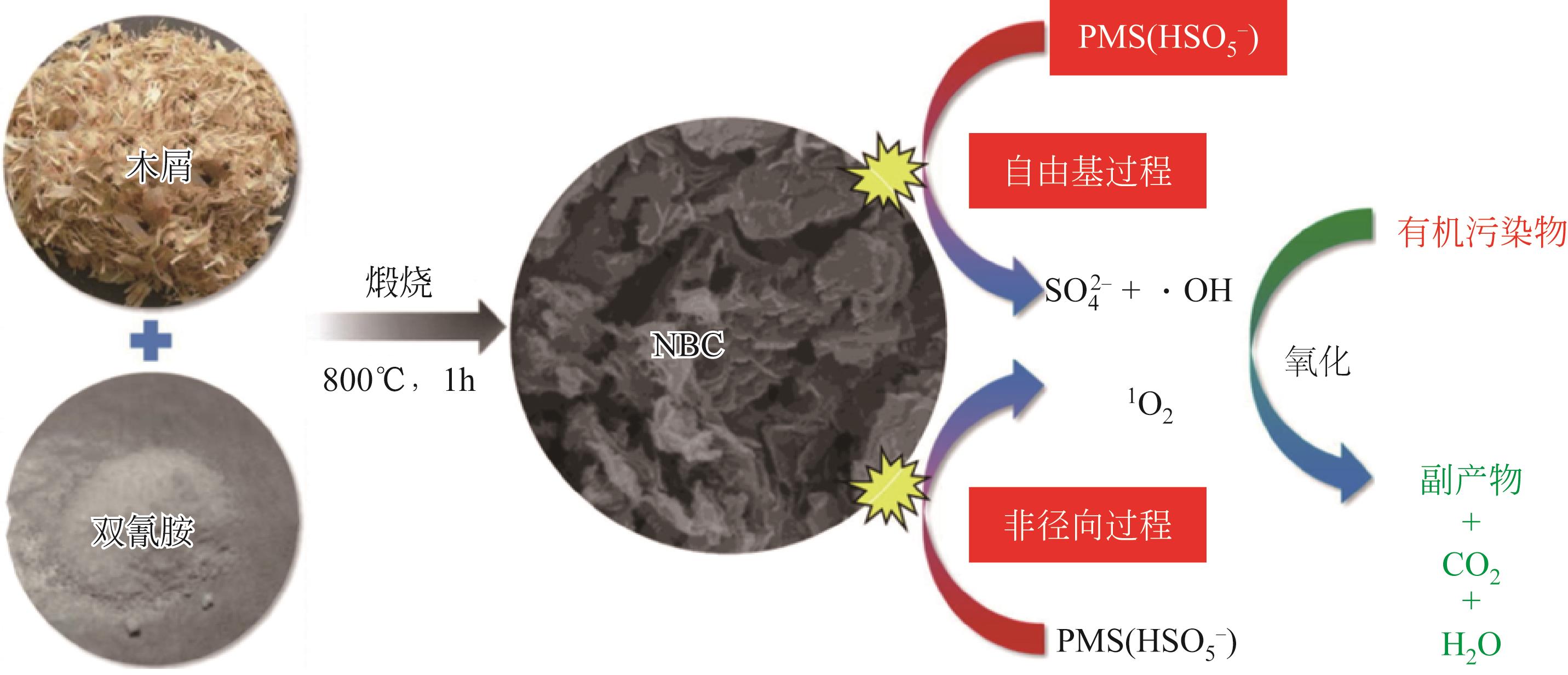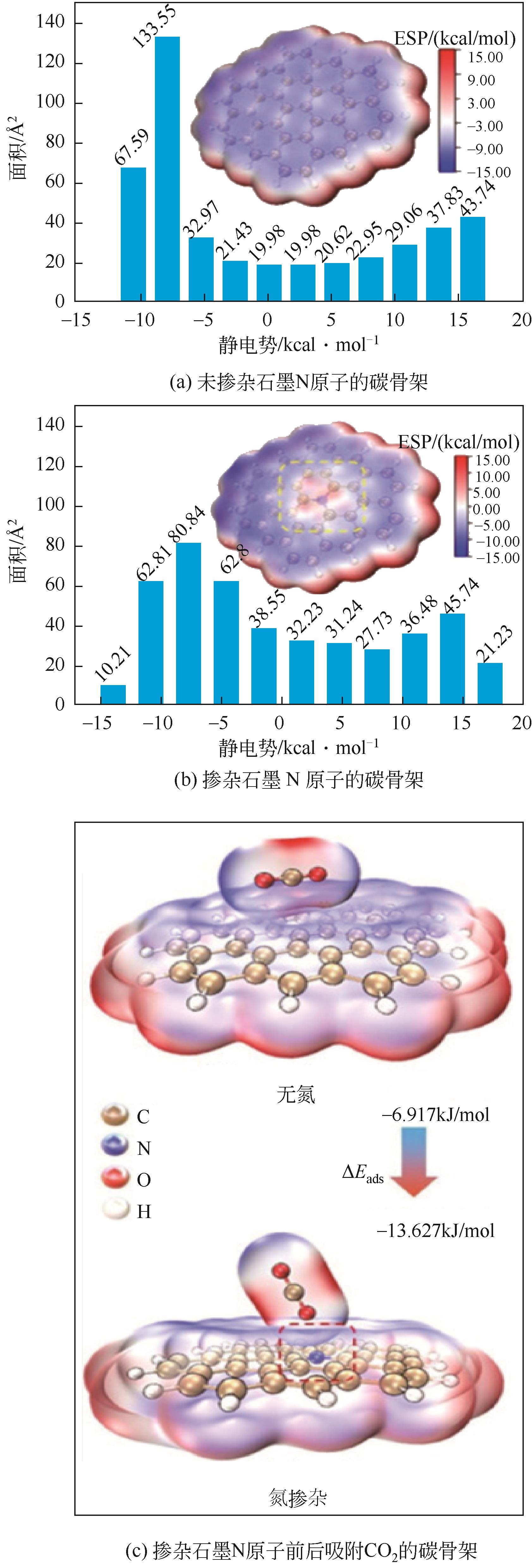化工进展 ›› 2023, Vol. 42 ›› Issue (7): 3720-3735.DOI: 10.16085/j.issn.1000-6613.2022-1563
氮掺杂生物炭的制备与应用研究进展
李艳玲1( ), 卓振1, 池亮2, 陈曦1, 孙堂磊1, 刘鹏1(
), 卓振1, 池亮2, 陈曦1, 孙堂磊1, 刘鹏1( ), 雷廷宙1(
), 雷廷宙1( )
)
- 1.常州大学城乡矿山研究院,常州市生物质绿色安全高值利用技术重点实验室,江苏 常州 213164
2.中国石油吉林石化公司乙烯厂,吉林 吉林 132022
-
收稿日期:2022-08-23修回日期:2022-12-21出版日期:2023-07-15发布日期:2023-08-14 -
通讯作者:刘鹏,雷廷宙 -
作者简介:李艳玲(1992—),女,博士研究生,硕士生导师,研究方向为生物质资源化利用。E-mail:liyl@cczu.edu.cn。 -
基金资助:常州市科技项目应用基础研究计划(CJ20220138);国家自然科学基金(51906021);现代农业-碳达峰碳中和科技创新专项资金(农业农村领域重大关键技术攻关)(BE2022426)
Research progress on preparation and application of nitrogen-doped biochar
LI Yanling1( ), ZHUO Zhen1, CHI Liang2, CHEN Xi1, SUN Tanglei1, LIU Peng1(
), ZHUO Zhen1, CHI Liang2, CHEN Xi1, SUN Tanglei1, LIU Peng1( ), LEI Tingzhou1(
), LEI Tingzhou1( )
)
- 1.Institute of Urban and Rural Mining, Changzhou Key Laboratory of Green Safe and High Value Utilization Technology of Biomass, Changzhou University, Changzhou 213164, Jiangsu, China
2.Ethylene Plant, PetroChina Jilin Petrochemical Company, Jilin 132022, Jilin, China
-
Received:2022-08-23Revised:2022-12-21Online:2023-07-15Published:2023-08-14 -
Contact:LIU Peng, LEI Tingzhou
摘要:
生物质不仅储量丰富、分布广泛且可再生,是一种亟待高值化利用的资源。将其炭化后制备的生物炭具有良好的理化性质,常被用于吸附污染物、制作电极材料。但与活性炭相比,生物炭存在孔隙结构欠发达、表面官能团种类和数量稀少等问题,其应用受到了很大限制。通过对生物炭进行N元素掺杂改性制成N掺杂生物炭(NBC)可丰富生物炭孔隙结构和表面活性位点,提高吸附、导电和催化性能。本文综述了国内外近几年来关于NBC的制备/改性方法(热解法、活化法、水热法、模板法和后处理法等)及其优点和局限性,梳理了各方法得到的NBC的形貌结构及表面化学特征,概括了氮掺杂对NBC的催化、吸附、电化学性能的影响及NBC在各领域的应用。以“制备-结构-性能及应用”相结合的思路,从NBC的应用角度逆向出发,思考如何通过探究N掺杂机理和优化制备方法,来充分发挥NBC在各领域中的应用价值,并对今后该领域的研究发展提出了展望。
中图分类号:
引用本文
李艳玲, 卓振, 池亮, 陈曦, 孙堂磊, 刘鹏, 雷廷宙. 氮掺杂生物炭的制备与应用研究进展[J]. 化工进展, 2023, 42(7): 3720-3735.
LI Yanling, ZHUO Zhen, CHI Liang, CHEN Xi, SUN Tanglei, LIU Peng, LEI Tingzhou. Research progress on preparation and application of nitrogen-doped biochar[J]. Chemical Industry and Engineering Progress, 2023, 42(7): 3720-3735.
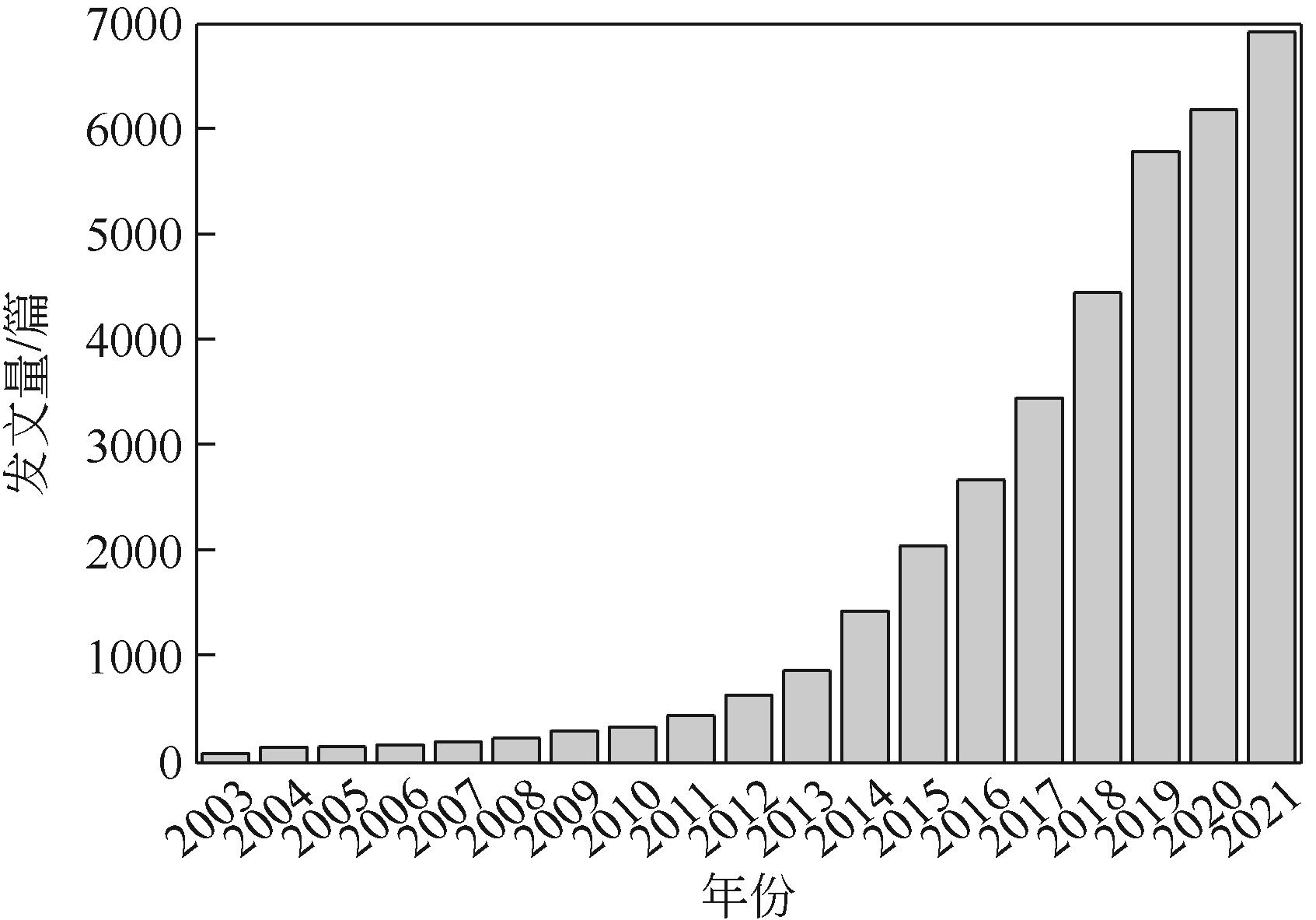
图1 近年来N掺杂生物炭的发文量[数据来源:在Web of Science数据库中以“N掺杂生物炭”的不同形式英文翻译(如N-doped biochar、N-doping biochar、nitrogen doped biochar、N-doped carbon、N-doping carbon)为关键词搜索]
| 制备方法 | 优点 | 缺点 |
|---|---|---|
| 原位掺杂法 | ||
| 活化 | 造孔性能优异、孔隙多为微孔 | 活化剂具有腐蚀性、工艺要求高、污染环境、反应机理复杂 |
| 水热 | 通过控制反应温度可以很好的调控含N官能团的种类和数量 | 孔隙少且多为中孔、结构不发达 |
| 热解 | 温度可调范围大、操作简单、炭产率高、N-Q含量高,最为常用 | 孔隙结构单一、比表面积有限、表面特征不理想 |
| 模板 | 可有效促进和严格把控NBC的孔隙结构和表面形态 | 去除模板剂造成浪费 |
| 后处理法 | N掺杂量较高、操作简单 | N掺杂不均匀、含N官能团数量少、掺杂效果不理想 |
表1 NBC各种制备方法的优缺点
| 制备方法 | 优点 | 缺点 |
|---|---|---|
| 原位掺杂法 | ||
| 活化 | 造孔性能优异、孔隙多为微孔 | 活化剂具有腐蚀性、工艺要求高、污染环境、反应机理复杂 |
| 水热 | 通过控制反应温度可以很好的调控含N官能团的种类和数量 | 孔隙少且多为中孔、结构不发达 |
| 热解 | 温度可调范围大、操作简单、炭产率高、N-Q含量高,最为常用 | 孔隙结构单一、比表面积有限、表面特征不理想 |
| 模板 | 可有效促进和严格把控NBC的孔隙结构和表面形态 | 去除模板剂造成浪费 |
| 后处理法 | N掺杂量较高、操作简单 | N掺杂不均匀、含N官能团数量少、掺杂效果不理想 |
| 原料 | 制备方法 | SBET/m2·g-1 | Smic/m2·g-1 | Vtotal/cm3·g-1 | Vmic/cm3·g-1 | d/nm | 文献 |
|---|---|---|---|---|---|---|---|
| 柚子皮 | 900℃热解 | 627.5 | 444.7 | 0.355 | 0.236 | 2.26 | [ |
| 豆浆 | CO2活化、热解 | 558.2 | 317.3 | 0.346 | 0.142 | 3.23 | [ |
| 芦苇 | 活化、热解 | 1074.0 | 489.0 | 0.996 | 0.543 | 1.85 | [ |
| 稻草 | 水热、活化、热解 | 2788.7 | — | 1.597 | 0.913 | — | [ |
| 稻草 | 活化、热解 | 2537.0 | — | 1.561 | — | — | [ |
| 椰壳 | ZnCl2活化、热解 | 1291.0 | — | 0.785 | 0.463 | 2.43 | [ |
表2 NBC材料的孔隙结构参数
| 原料 | 制备方法 | SBET/m2·g-1 | Smic/m2·g-1 | Vtotal/cm3·g-1 | Vmic/cm3·g-1 | d/nm | 文献 |
|---|---|---|---|---|---|---|---|
| 柚子皮 | 900℃热解 | 627.5 | 444.7 | 0.355 | 0.236 | 2.26 | [ |
| 豆浆 | CO2活化、热解 | 558.2 | 317.3 | 0.346 | 0.142 | 3.23 | [ |
| 芦苇 | 活化、热解 | 1074.0 | 489.0 | 0.996 | 0.543 | 1.85 | [ |
| 稻草 | 水热、活化、热解 | 2788.7 | — | 1.597 | 0.913 | — | [ |
| 稻草 | 活化、热解 | 2537.0 | — | 1.561 | — | — | [ |
| 椰壳 | ZnCl2活化、热解 | 1291.0 | — | 0.785 | 0.463 | 2.43 | [ |
| 原料 | 温度 /℃ | 吡啶氮 /% | 吡咯氮 /% | 石墨化氮 /% | 吡啶型氧化氮 /% | 文献 |
|---|---|---|---|---|---|---|
| 玉米秸秆 | 700 | 29.9 | 17.2 | 43.1 | 9.8 | [ |
| 竹渣 | 800 | 14.2 | 71.0 | 14.8 | — | [ |
| 木浆 | 900 | 44.3 | 19.5 | 36.2 | — | [ |
| 竹子 | 800 | 37.7 | 25.6 | 27.6 | 9.1 | [ |
| 水葫芦 | 800 | 43.2 | — | 56.8 | — | [ |
| 香蕉皮 | 600 | 26.2 | 38.5 | 35.3 | — | [ |
| 樟子松 | 600 | 37.7 | 46.5 | 15.8 | — | [ |
表3 NBC中含N组分的种类及占比
| 原料 | 温度 /℃ | 吡啶氮 /% | 吡咯氮 /% | 石墨化氮 /% | 吡啶型氧化氮 /% | 文献 |
|---|---|---|---|---|---|---|
| 玉米秸秆 | 700 | 29.9 | 17.2 | 43.1 | 9.8 | [ |
| 竹渣 | 800 | 14.2 | 71.0 | 14.8 | — | [ |
| 木浆 | 900 | 44.3 | 19.5 | 36.2 | — | [ |
| 竹子 | 800 | 37.7 | 25.6 | 27.6 | 9.1 | [ |
| 水葫芦 | 800 | 43.2 | — | 56.8 | — | [ |
| 香蕉皮 | 600 | 26.2 | 38.5 | 35.3 | — | [ |
| 樟子松 | 600 | 37.7 | 46.5 | 15.8 | — | [ |
| 炭源 | 氮源 | 制备工艺 | N组分/% | N类型 | 作用 | 文献 |
|---|---|---|---|---|---|---|
| 竹子 | NH3 | 热解 | 3.42 | N-5、N-6、N-Q、N-X | NBC作催化剂促进了苯酚的生成同时抑制了乙酸的产生,提高了产物产量和生物油的质量 | [ |
| 木屑 | 双氰胺 | 热解 | 20.32 | N-6、N-Q | NBC丰富的缺陷结构和N-Q、N-6表现出了较好的催化活性,可以有效降解苯酚、对乙酰氨基酚、磺胺甲𫫇唑 | [ |
| 玉米芯 | 三聚氰胺 | 水热炭化、热解 | 27.19 | N-5、N-6、N-Q | 氮掺杂技术提高了石墨化水平和N-5相对含量,从而促进了电导率,提高了微生物生物制氢的效率 | [ |
| 玉米芯 | 吡咯 | 热解、CO2活化 | 6.17 | N-Q、N-6 | 大量的N-Q提高了导电率和电催化活性,丰富的孔隙结构有效负载了Fe2O3,使其ORR催化性能优于商业的Pt/C催化剂 | [ |
| 苎麻树皮 | 尿素 | 活化、热解 | 2.12 | N-Q、N-5、N-6 | NBC中的N-Q、缺陷位点提供了四环素催化降解的活性位点,低阻抗和高的电子转移速率也是催化性高的关键 | [ |
| 葡萄糖 | 三聚氰胺 | 热解法 | — | N-Q | NBC负载Cu用作还原对硝基苯酚的催化剂,N-Q的π-π键促进了催化降解 | [ |
| 柚皮 | 三聚氰胺 | NaHCO3活化、热解 | 13.54 | N-5、N-Q | NBC的N结构作为过硫酸氢盐活化的活性中心,催化去除了磺胺甲𫫇唑等抗生素污染物 | [ |
表4 NBC在催化方面的应用
| 炭源 | 氮源 | 制备工艺 | N组分/% | N类型 | 作用 | 文献 |
|---|---|---|---|---|---|---|
| 竹子 | NH3 | 热解 | 3.42 | N-5、N-6、N-Q、N-X | NBC作催化剂促进了苯酚的生成同时抑制了乙酸的产生,提高了产物产量和生物油的质量 | [ |
| 木屑 | 双氰胺 | 热解 | 20.32 | N-6、N-Q | NBC丰富的缺陷结构和N-Q、N-6表现出了较好的催化活性,可以有效降解苯酚、对乙酰氨基酚、磺胺甲𫫇唑 | [ |
| 玉米芯 | 三聚氰胺 | 水热炭化、热解 | 27.19 | N-5、N-6、N-Q | 氮掺杂技术提高了石墨化水平和N-5相对含量,从而促进了电导率,提高了微生物生物制氢的效率 | [ |
| 玉米芯 | 吡咯 | 热解、CO2活化 | 6.17 | N-Q、N-6 | 大量的N-Q提高了导电率和电催化活性,丰富的孔隙结构有效负载了Fe2O3,使其ORR催化性能优于商业的Pt/C催化剂 | [ |
| 苎麻树皮 | 尿素 | 活化、热解 | 2.12 | N-Q、N-5、N-6 | NBC中的N-Q、缺陷位点提供了四环素催化降解的活性位点,低阻抗和高的电子转移速率也是催化性高的关键 | [ |
| 葡萄糖 | 三聚氰胺 | 热解法 | — | N-Q | NBC负载Cu用作还原对硝基苯酚的催化剂,N-Q的π-π键促进了催化降解 | [ |
| 柚皮 | 三聚氰胺 | NaHCO3活化、热解 | 13.54 | N-5、N-Q | NBC的N结构作为过硫酸氢盐活化的活性中心,催化去除了磺胺甲𫫇唑等抗生素污染物 | [ |
| 炭源 | 氮源 | 吸附质 | 制备工艺 | 比表面积 /m2·g-1 | 孔容 /cm3·g-1 | N类型 | 机理 | 文献 |
|---|---|---|---|---|---|---|---|---|
| 蓝藻 | 蓝藻 | CO2 | 热解 | 1148 | 0.52 | N-5、N-6、N-Q | 孔隙结构与N-Q提供了吸附CO2所需的活性位点 | [ |
| 椰壳 | 椰壳 | SO2 | CO2活化、水热炭化 | 706 | 0.45 | N-5、N-6、N-Q | SO2分子与含N官能团的静电作用N掺杂增强了炭基表面对SO2的吸附 | [ |
| 椰壳 | 尿素 | CO2 | K2CO3活化、后处理 | 1324 | 0.51 | N-5、N-6、N-Q | 高的比表面积和多种含N官能团共同促进了对CO2的吸附 | [ |
| 竹子 | 尿素 | 苯酚、亚甲基蓝 | KHCO3活化、热解 | 1693 | 0.90 | N-5、N-6、N-X | 含N官能团的引入增强了生物炭的表面活性,提高了对苯酚、亚甲基蓝的吸附量 | [ |
| 玉米秸秆 | 尿素 | 苯酚 | NaHCO3活化、热解 | 619 | 0.38 | N-6、N-Q | 微孔填充作用、N-6与苯酚分子间的Lewis酸碱相互作用、N-Q与苯酚分子形成π-π键 | [ |
| 玉米秸秆 | NH3 | Cu2+、Cd2+ | 热解 | 418 | 0.28 | N-Q | 阳离子π键和与炭表面N-Q和—OH的络合 | [ |
| 茶树 | 尿素 | Cu2+、Pb2+ | ZnCl2活化、水热炭化 | 63 | 0.30 | N-6、N-Q | 氢键、螯合作用、N-Q和—OH的表面络合作用提高了对重金属离子的吸附 | [ |
| 莲藕 | 莲藕 | 甲基橙 | N2氛围900℃热解4h | 693 | 0.38 | N-5、N-6、N-Q | 通过官能团和孔隙吸附作用吸附甲基橙 | [ |
| 腐殖酸 | 尿素 | Cd2+、As3+、As6+ | N2氛围700℃热解2h | 526 | — | N-Q、N-6 | 阳离子π键、N-Q和—OH的 络合 | [ |
表5 NBC在吸附方面的应用
| 炭源 | 氮源 | 吸附质 | 制备工艺 | 比表面积 /m2·g-1 | 孔容 /cm3·g-1 | N类型 | 机理 | 文献 |
|---|---|---|---|---|---|---|---|---|
| 蓝藻 | 蓝藻 | CO2 | 热解 | 1148 | 0.52 | N-5、N-6、N-Q | 孔隙结构与N-Q提供了吸附CO2所需的活性位点 | [ |
| 椰壳 | 椰壳 | SO2 | CO2活化、水热炭化 | 706 | 0.45 | N-5、N-6、N-Q | SO2分子与含N官能团的静电作用N掺杂增强了炭基表面对SO2的吸附 | [ |
| 椰壳 | 尿素 | CO2 | K2CO3活化、后处理 | 1324 | 0.51 | N-5、N-6、N-Q | 高的比表面积和多种含N官能团共同促进了对CO2的吸附 | [ |
| 竹子 | 尿素 | 苯酚、亚甲基蓝 | KHCO3活化、热解 | 1693 | 0.90 | N-5、N-6、N-X | 含N官能团的引入增强了生物炭的表面活性,提高了对苯酚、亚甲基蓝的吸附量 | [ |
| 玉米秸秆 | 尿素 | 苯酚 | NaHCO3活化、热解 | 619 | 0.38 | N-6、N-Q | 微孔填充作用、N-6与苯酚分子间的Lewis酸碱相互作用、N-Q与苯酚分子形成π-π键 | [ |
| 玉米秸秆 | NH3 | Cu2+、Cd2+ | 热解 | 418 | 0.28 | N-Q | 阳离子π键和与炭表面N-Q和—OH的络合 | [ |
| 茶树 | 尿素 | Cu2+、Pb2+ | ZnCl2活化、水热炭化 | 63 | 0.30 | N-6、N-Q | 氢键、螯合作用、N-Q和—OH的表面络合作用提高了对重金属离子的吸附 | [ |
| 莲藕 | 莲藕 | 甲基橙 | N2氛围900℃热解4h | 693 | 0.38 | N-5、N-6、N-Q | 通过官能团和孔隙吸附作用吸附甲基橙 | [ |
| 腐殖酸 | 尿素 | Cd2+、As3+、As6+ | N2氛围700℃热解2h | 526 | — | N-Q、N-6 | 阳离子π键、N-Q和—OH的 络合 | [ |
| 炭源 | 氮源 | 制备工艺 | 比表面积 /m2·g-1 | 孔容 /cm3·g-1 | 储能器类型 | 产品特性 | 文献 |
|---|---|---|---|---|---|---|---|
| 麦秸秆 | 三聚氰胺 | KCl和ZnCl2作为盐模板 | 1201 | 1.02 | 超级电容器 | 可逆比电容223F/g(0.5A/g),次循电容保持率91.4%(10000) | [ |
| 稻秸秆 | 尿素 | K2CO3活化、水热、热解 | 2800 | 1.60 | 超级电容器 | 可逆比电容380F/g(0.5A/g),电容保持率95.4%(10000) | [ |
| 漆籽纤维 | 铁氰化钾 | 预炭化、高温活化 | 407 | 0.39 | 超级电容器 | 可逆比电容324F/g(0.2A/g),3000电容保持率97.0%(3000) | [ |
| 香菇 | 香菇 | KOH活化、浸泡 | 1930 | 0.86 | 超级电容器 | 比电容为325F/g(0.5A/g),电容保持率为97.7%(5000) | [ |
| 菜籽饼 | 三聚氰胺 | K2CO3活化、热解 | 2050 | 1.13 | 超级电容器 | 比电容274F/g(0.05A/g),电容保持率96.0%(10000) | [ |
| 头发 | 头发 | 热解、活化 | 1617 | 0.70 | 钠离子电池 | 可逆比电容为700mAh/g(0.13C) | [ |
| 木耳 | 木耳 | 冻干、热解 | 1568 | — | 锂硫电池 | 可逆比电容为875mAh/g(0.20C) | [ |
| 木材 | 三聚氰胺 | 熔融盐模板、热解 | 621 | 0.34 | 锂氧电池 | 放电比电容为9.44mA·h/cm2(0.05mA/cm2),可循环113次(0.5mA/cm2) | [ |
表6 NBC在电化学储能方面的应用
| 炭源 | 氮源 | 制备工艺 | 比表面积 /m2·g-1 | 孔容 /cm3·g-1 | 储能器类型 | 产品特性 | 文献 |
|---|---|---|---|---|---|---|---|
| 麦秸秆 | 三聚氰胺 | KCl和ZnCl2作为盐模板 | 1201 | 1.02 | 超级电容器 | 可逆比电容223F/g(0.5A/g),次循电容保持率91.4%(10000) | [ |
| 稻秸秆 | 尿素 | K2CO3活化、水热、热解 | 2800 | 1.60 | 超级电容器 | 可逆比电容380F/g(0.5A/g),电容保持率95.4%(10000) | [ |
| 漆籽纤维 | 铁氰化钾 | 预炭化、高温活化 | 407 | 0.39 | 超级电容器 | 可逆比电容324F/g(0.2A/g),3000电容保持率97.0%(3000) | [ |
| 香菇 | 香菇 | KOH活化、浸泡 | 1930 | 0.86 | 超级电容器 | 比电容为325F/g(0.5A/g),电容保持率为97.7%(5000) | [ |
| 菜籽饼 | 三聚氰胺 | K2CO3活化、热解 | 2050 | 1.13 | 超级电容器 | 比电容274F/g(0.05A/g),电容保持率96.0%(10000) | [ |
| 头发 | 头发 | 热解、活化 | 1617 | 0.70 | 钠离子电池 | 可逆比电容为700mAh/g(0.13C) | [ |
| 木耳 | 木耳 | 冻干、热解 | 1568 | — | 锂硫电池 | 可逆比电容为875mAh/g(0.20C) | [ |
| 木材 | 三聚氰胺 | 熔融盐模板、热解 | 621 | 0.34 | 锂氧电池 | 放电比电容为9.44mA·h/cm2(0.05mA/cm2),可循环113次(0.5mA/cm2) | [ |
| 1 | 孙书晶, 曾旭. 生物质热解炭化及其资源利用进展[J]. 化工设计通讯, 2017, 43(4): 207. |
| SUN Shujing, ZENG Xu. Biomass pyrolysis carbonization and its resource utilization[J]. Chemical Engineering Design Communications, 2017, 43(4): 207. | |
| 2 | LIU Wujun, TIAN Ke, HE Yanrong, et al. High-yield harvest of nanofibers/mesoporous carbon composite by pyrolysis of waste biomass and its application for high durability electrochemical energy storage[J]. Environmental Science & Technology, 2014, 48(23): 13951-13959. |
| 3 | ATINAFU D G, YUN Beom Yeol, KIM Young Uk, et al. Introduction of eicosane into biochar derived from softwood and wheat straw: Influence of porous structure and surface chemistry[J]. Chemical Engineering Journal, 2021, 415: 128887. |
| 4 | 简敏菲, 高凯芳, 余厚平. 不同裂解温度对水稻秸秆制备生物炭及其特性的影响[J]. 环境科学学报, 2016, 36(5): 1757-1765. |
| JIAN Minfei, GAO Kaifang, YU Houping. Effects of different pyrolysis temperatures on the preparation and characteristics of bio-char from rice straw[J]. Acta Scientiae Circumstantiae, 2016, 36(5): 1757-1765. | |
| 5 | LIU Yun, XU Huanghui, YU Hongfei, et al. Synthesis of lignin-derived nitrogen-doped carbon as a novel catalyst for 4-NP reduction evaluation[J]. Scientific Reports, 2020, 10(1): 1-14. |
| 6 | ZHANG Zhicheng, CHEN Luxi, WANG Jiang, et al. Biochar preparation from Solidago canadensis and its alleviation of the inhibition of tomato seed germination by allelochemicals[J]. RSC Advances, 2018, 8(40): 22370-22375. |
| 7 | CHENG Binhai, ZENG R J, JIANG Hong. Recent developments of post-modification of biochar for electrochemical energy storage[J]. Bioresource Technology, 2017, 246: 224-233. |
| 8 | 计海洋, 汪玉瑛, 刘玉学, 等. 生物炭及改性生物炭的制备与应用研究进展[J]. 核农学报, 2018, 32(11): 2281-2287. |
| JI Haiyang, WANG Yuying, LIU Yuxue, et al. Advance in preparation and application of biochar and modified biochar research[J]. Journal of Nuclear Agricultural Sciences, 2018, 32(11): 2281-2287. | |
| 9 | 刘影影. 生物质热解炭的高值化利用研究[D]. 杭州: 浙江大学, 2019. |
| LIU Yingying. Research on high-value utilization of biomass pyrolytic carbon[D]. Hangzhou: Zhejiang University, 2019. | |
| 10 | LIU Huachen, ZHANG Feng, WU Zhaofeng, et al. Nitrogen-doped porous carbon derived from cellulose microfibers of rice straw for high-performance electrodes of supercapacitors[J]. Energy & Fuels, 2021, 35(12): 10190-10198. |
| 11 | WAN Zhonghao, SUN Yuqing, TSANG Daniel C W, et al. Customised fabrication of nitrogen-doped biochar for environmental and energy applications[J]. Chemical Engineering Journal, 2020, 401: 126136. |
| 12 | LIU Chao, CHEN Liwei, DING Dahu, et al. From rice straw to magnetically recoverable nitrogen doped biochar: Efficient activation of peroxymonosulfate for the degradation of metolachlor[J]. Applied Catalysis B: Environmental, 2019, 254: 312-320. |
| 13 |
SUI Long, TANG Chunyu, DU Qing, et al. Preparation and characterization of boron-doped corn straw biochar: Fe( ) removal equilibrium and kinetics[J]. Journal of Environmental Sciences, 2021, 106: 116-123. ) removal equilibrium and kinetics[J]. Journal of Environmental Sciences, 2021, 106: 116-123.
|
| 14 | LIU Fangyan, WANG Zixing, ZHANG Haitao, et al. Nitrogen, oxygen and sulfur co-doped hierarchical porous carbons toward high-performance supercapacitors by direct pyrolysis of kraft lignin[J]. Carbon, 2019, 149: 105-116. |
| 15 | DING Dahu, YANG Shengjiong, QIAN Xiaoyong, et al. Nitrogen-doping positively whilst sulfur-doping negatively affect the catalytic activity of biochar for the degradation of organic contaminant[J]. Applied Catalysis B: Environmental, 2020, 263: 118348. |
| 16 | MA Linlin, HU Xiao, LIU Wujun, et al. Constructing N,P-dually doped biochar materials from biomass wastes for high-performance bifunctional oxygen electrocatalysts[J]. Chemosphere, 2021, 278: 130508. |
| 17 | SUO Fengyue, YOU Xiangwei, MA Yongqiang, et al. Rapid removal of triazine pesticides by P doped biochar and the adsorption mechanism[J]. Chemosphere, 2019, 235: 918-925. |
| 18 | 张月. 生物炭的氧化还原机制及其环境应用[D]. 上海: 上海交通大学, 2019. |
| ZHANG Yue. Redox mechanism of biochar and its environmental application[D]. Shanghai: Shanghai Jiao Tong University, 2019. | |
| 19 | LI Dan, CHEN Wenhua, WU Jianping, et al. The preparation of waste biomass-derived N-doped carbons and their application in acid gas removal: Focus on N functional groups[J]. Journal of Materials Chemistry A, 2020, 8(47): 24977-24995. |
| 20 | YUE Limin, XIA Qiongzhang, WANG Liwei, et al. CO2 adsorption at nitrogen-doped carbons prepared by K2CO3 activation of urea-modified coconut shell[J]. Journal of Colloid and Interface Science, 2018, 511: 259-267. |
| 21 | WANG He, WANG Han, LIU Guoshuai, et al. In-situ pyrolysis of Taihu blue algae biomass as appealing porous carbon adsorbent for CO2 capture: Role of the intrinsic N[J]. Science of the Total Environment, 2021, 771: 145424. |
| 22 | LIANG Hongxu, SUN Ruru, SONG Bin, et al. Preparation of nitrogen-doped porous carbon material by a hydrothermal-activation two-step method and its high-efficiency adsorption of Cr(Ⅵ)[J]. Journal of Hazardous Materials, 2020, 387: 121987. |
| 23 | ZHOU Yunlong, WANG Jian, SUN Meng, et al. Adsorption of CO2 by nitrogen doped corn straw based biochar[J]. Arabian Journal of Geosciences, 2021, 14(18): 1875. |
| 24 | ZHANG Shun, TIAN Ke, CHENG Binhai, et al. Preparation of N-doped supercapacitor materials by integrated salt templating and silicon hard templating by pyrolysis of biomass wastes[J]. ACS Sustainable Chemistry & Engineering, 2017, 5(8): 6682-6691. |
| 25 | ZHANG Jishi, YANG Mengchen, ZHAO Wenqian, et al. Biohydrogen production amended with nitrogen-doped biochar[J]. Energy & Fuels, 2021, 35(2): 1476-1487. |
| 26 | 余正发, 王旭珍, 刘宁, 等. N掺杂多孔碳材料研究进展[J]. 化工进展, 2013, 32(4): 824-831. |
| YU Zhengfa, WANG Xuzhen, LIU Ning, et al. Recent progress of N-doped porous carbon materials[J]. Chemical Industry and Engineering Progress, 2013, 32(4): 824-831, 862. | |
| 27 | CHEN Zuo, ZHANG Man, WANG Yuchen, et al. Controllable synthesis of nitrogen-doped porous carbon from metal-polluted miscanthus waste boosting for supercapacitors[J]. Green Energy & Environment, 2021, 6(6): 929-937. |
| 28 | 郭莎莎. 茶树废弃枝条制备氮掺杂碳材料对重金属离子的吸附与检测[D]. 杨凌: 西北农林科技大学, 2020. |
| GUO Shasha. Preparation of camellia sinensis waste branch-derived N-doped carbon materials and its applications on heavy metal adsorption and detection[D]. Yangling: Northwest A & F University, 2020. | |
| 29 | YU Shuai, ZHU Xinqiang, LOU Gaobo, et al. Sustainable hierarchical porous biomass carbons enriched with pyridinic and pyrrolic nitrogen for asymmetric supercapacitor[J]. Materials & Design, 2018, 149: 184-193. |
| 30 | MOU Xiaoling, MA Jiaxin, ZHENG Shuanghao, et al. A general synthetic strategy toward highly doped pyridinic nitrogen‐rich carbons[J]. Advanced Functional Materials, 2021, 31(3): 2006076. |
| 31 | CHAROENSOOK K, HUANG Chengliang, TAI Hungchun, et al. Preparation of porous nitrogen-doped activated carbon derived from rice straw for high-performance supercapacitor application[J]. Journal of the Taiwan Institute of Chemical Engineers, 2021, 120: 246-256. |
| 32 | LI Qiaoyan, HOU Yaqin, WANG Jiancheng, et al. Superiority of raw biomass and potassium hydroxide in preparation of ultrahigh nitrogen doping of carbon for NH3-SCR reaction[J]. ACS Sustainable Chemistry & Engineering, 2020, 8(30): 11308-11316. |
| 33 | HU Zhonghua, SRINIVASAN M P, NI Yaming. Novel activation process for preparing highly microporous and mesoporous activated carbons[J]. Carbon, 2001, 39(6): 877-886. |
| 34 | CHENG Hu, JI Rongting, BIAN Yongrong, et al. From macroalgae to porous graphitized nitrogen-doped biochars—Using aquatic biota to treat polycyclic aromatic hydrocarbons-contaminated water[J]. Bioresource Technology, 2020, 303: 122947. |
| 35 | 任秀丽. 氯化锌活化法制备多孔碳材料及其性能研究[D]. 延吉: 延边大学, 2015. |
| REN Xiuli. Preparation of porous carbon materials by ZnCl2 activation and the study on its properties[D]. Yanji: Yanbian University, 2015. | |
| 36 | 朱晓, 张立强, 张梦泽, 等. 水热法制备氮掺杂多孔炭及其在气体吸附/电化学储能中的应用[J]. 燃烧科学与技术, 2020, 26(5): 413-422. |
| ZHU Xiao, ZHANG Liqiang, ZHANG Mengze, et al. Preparation of N-doped porous carbon by hydrothermal method and its application in gas adsorption/electrochemical energy storage[J]. Journal of Combustion Science and Technology, 2020, 26(5): 413-422. | |
| 37 | LI Ning, HE Mengting, LU Xukai, et al. Municipal solid waste derived biochars for wastewater treatment: Production, properties and applications[J]. Resources, Conservation and Recycling, 2022, 177: 106003. |
| 38 | LI Yunchao, XING Bo, WANG Xiaoliu, et al. Nitrogen-doped hierarchical porous biochar derived from corn stalks for phenol-enhanced adsorption[J]. Energy & Fuels, 2019, 33(12): 12459-12468. |
| 39 | WANG Junrui, WAN Feng, LU Qiufeng, et al. Self-nitrogen-doped porous biochar derived from kapok (Ceiba insignis) fibers: Effect of pyrolysis temperature and high electrochemical performance[J]. Journal of Materials Science & Technology, 2018, 34(10): 1959-1968. |
| 40 | LI Zhenhao, XING Bo, DING Yan, et al. A high-performance biochar produced from bamboo pyrolysis with in-situ nitrogen doping and activation for adsorption of phenol and methylene blue[J]. Chinese Journal of Chemical Engineering, 2020, 28(11): 2872-2880. |
| 41 | CHEN Xiangying, CHEN Chong, ZHANG Zhongjie, et al. Nitrogen-doped porous carbon prepared from urea formaldehyde resins by template carbonization method for supercapacitors[J]. Industrial & Engineering Chemistry Research, 2013, 52(30): 10181-10188. |
| 42 | 陈彰旭, 郑炳云, 李先学, 等. 模板法制备纳米材料研究进展[J]. 化工进展, 2010, 29(1): 94-99. |
| CHEN Zhangxu, ZHENG Bingyun, LI Xianxue, et al. Progress in the preparation of nanomaterials employing template method[J]. Chemical Industry and Engineering Progress, 2010, 29(1): 94-99. | |
| 43 | HUANG Shuqiong, DING Yan, LI Yunchao, et al. Nitrogen and sulfur co-doped hierarchical porous biochar derived from the pyrolysis of mantis shrimp shell for supercapacitor electrodes[J]. Energy & Fuels, 2021, 35(2): 1557-1566. |
| 44 | 陈金辉. 氮掺杂炭负载钌催化剂的制备及其催化加氢性能研究[D]. 杭州: 浙江工业大学, 2020. |
| CHEN Jinhui. Effect of nitrogen-doping on hydrogenation performance of carbon supported ruthenium catalyst[D]. Hangzhou: Zhejiang University of Technology, 2020. | |
| 45 | GENG Zhen, XIAO Qiangfeng, Hong LYU, et al. One-step synthesis of microporous carbon monoliths derived from biomass with high nitrogen doping content for highly selective CO2 capture[J]. Scientific Reports, 2016, 6: 30049. |
| 46 | ZHANG Xiaodi, XU Ying, ZHANG Guojie, et al. Nitrogen-doped porous carbons derived from sustainable biomass via a facile post-treatment nitrogen doping strategy: Efficient CO2 capture and DRM[J]. International Journal of Hydrogen Energy, 2022, 47(58): 24388-24397. |
| 47 | XU Xiaoyun, ZHENG Yulin, GAO Bin, et al. N-doped biochar synthesized by a facile ball-milling method for enhanced sorption of CO2 and reactive red[J]. Chemical Engineering Journal, 2019, 368: 564-572. |
| 48 | PANDOLFO A G, HOLLENKAMP A F. Carbon properties and their role in supercapacitors[J]. Journal of Power Sources, 2006, 157(1): 11-27. |
| 49 | FRACKOWIAK E, BEGUIN F. Carbon materials for the electrochemical storage of energy in capacitors[J]. Carbon, 2001, 39(6): 937-950. |
| 50 | DING Yan, LI Yunchao, DAI Yujie, et al. A novel approach for preparing in-situ nitrogen doped carbon via pyrolysis of bean pulp for supercapacitors[J]. Energy, 2021, 216: 119227. |
| 51 | WANG Zhen, TAN Yongtao, YANG Yunlong, et al. Pomelo peels-derived porous activated carbon microsheets dual-doped with nitrogen and phosphorus for high performance electrochemical capacitors[J]. Journal of Power Sources, 2018, 378: 499-510. |
| 52 | WANG Li, YAN Wei, HE Chi, et al. Microwave-assisted preparation of nitrogen-doped biochars by ammonium acetate activation for adsorption of acid red 18[J]. Applied Surface Science, 2018, 433: 222-231. |
| 53 | 马晓, 秦晓伟, 张晓娣, 等. 氮掺杂生物质碳材料催化剂的制备及其催化CH4-CO2重整性能[J]. 洁净煤技术, 2022, 28(5): 59-70. |
| MA Xiao, QIN Xiaowei, ZHANG Xiaodi, et al. Preparation of biomass nitrogen-doped carbon material catalyst and its catalytic performance for CO2 reforming of CH4 [J]. Clean Coal Technology, 2022, 28(5): 59-70. | |
| 54 | WEI Xianjun, JIANG Xiaoqiang, WEI Jishi, et al. Functional groups and pore size distribution do matter to hierarchically porous carbons as high-rate-performance supercapacitors[J]. Chemistry of Materials, 2016, 28(2): 445-458. |
| 55 | SARAVANAN K R, KALAISELVI N. Nitrogen containing bio-carbon as a potential anode for lithium batteries[J]. Carbon, 2015, 81: 43-53. |
| 56 | CHEN Xiangying, CHEN Chong, ZHANG Zhongjie, et al. Nitrogen-doped porous carbon for supercapacitor with long-term electrochemical stability[J]. Journal of Power Sources, 2013, 230: 50-58. |
| 57 | LIU Tao, ZHOU Hanfeng, LAN Yingying, et al. Preparation of high-performance, three-dimensional, hierarchical porous carbon supercapacitor materials and high-value-added potassium humate from cotton stalks[J]. Diamond and Related Materials, 2021, 116: 108375. |
| 58 | ZHANG Ji, SHANG Tongxin, JIN Xiaojuan, et al. Study of chromium (Ⅵ) removal from aqueous solution using nitrogen-enriched activated carbon based bamboo processing residues[J]. RSC Advances, 2015, 5(1): 784-790. |
| 59 | HUANG Peng, ZHANG Peng, WANG Cuiping, et al. Enhancement of persulfate activation by Fe-biochar composites: Synergism of Fe and N-doped biochar[J]. Applied Catalysis B: Environmental, 2022, 303: 120926. |
| 60 | CHEN Wei, YANG Haiping, CHEN Yingquan, et al. Biomass pyrolysis for nitrogen-containing liquid chemicals and nitrogen-doped carbon materials[J]. Journal of Analytical and Applied Pyrolysis, 2016, 120: 186-193. |
| 61 | LIANG Jiaxiang, TANG Diyong, HUANG Li, et al. High oxygen reduction reaction performance nitrogen-doped biochar cathode: A strategy for comprehensive utilizing nitrogen and carbon in water hyacinth[J]. Bioresource Technology, 2018, 267: 524-531. |
| 62 | RONG Xing, XIE Meng, KONG Lingshuai, et al. The magnetic biochar derived from banana peels as a persulfate activator for organic contaminants degradation[J]. Chemical Engineering Journal, 2019, 372: 294-303. |
| 63 | WANG Xiaoliu, LIU Yingying, ZHU Lingjun, et al. Biomass derived N-doped biochar as efficient catalyst supports for CO2 methanation[J]. Journal of CO2 Utilization, 2019, 34: 733-741. |
| 64 | SUN Kangkang, SUN Jialin, LU Guoping, et al. Enhanced catalytic activity of cobalt nanoparticles encapsulated with an N-doped porous carbon shell derived from hollow ZIF-8 for efficient synthesis of nitriles from primary alcohols in water[J]. Green Chemistry, 2019, 21(16): 4334-4340. |
| 65 | 李宇明, 刘梓烨, 张启扬, 等. 氮掺杂碳材料的制备及其在催化领域中的应用[J]. 化工学报, 2021, 72(8): 3919-3932. |
| LI Yuming, LIU Ziye, ZHANG Qiyang, et al. Preparation of nitrogen-doped carbon materials and their applications in catalysis[J]. CIESC Journal, 2021, 72(8): 3919-3932. | |
| 66 | XIA Dongsheng, TANG Fei, YAO Xiaozhang, et al. Seeded growth of branched iron-nitrogen-doped carbon nanotubes as a high performance and durable non-precious fuel cell cathode[J]. Carbon, 2020, 162: 300-307. |
| 67 | 陈宇卓, 王哲, 毛善俊, 等. 基于氮掺杂多孔炭的加氢催化剂的理性设计[J]. 催化学报, 2019, 40(7): 971-979. |
| CHEN Yuzhuo, WANG Zhe, MAO Shanjun, et al. Rational design of hydrogenation catalysts using nitrogen-doped porous carbon[J].Chinese Journal of Catalysis, 2019, 40(7): 971-979. | |
| 68 | CHEN Wei, FANG Yang, LI Kaixu, et al. Bamboo wastes catalytic pyrolysis with N-doped biochar catalyst for phenols products[J]. Applied Energy, 2020, 260: 114242. |
| 69 | XU Lu, WU Chenxi, LIU Peihua, et al. Peroxymonosulfate activation by nitrogen-doped biochar from sawdust for the efficient degradation of organic pollutants[J]. Chemical Engineering Journal, 2020, 387: 124065. |
| 70 | YAN Wei, WU Yanling, CHEN Yanli, et al. Facile preparation of N-doped corncob-derived carbon nanofiber efficiently encapsulating Fe2O3 nanocrystals towards high ORR electrocatalytic activity[J]. Journal of Energy Chemistry, 2020, 44: 121-130. |
| 71 | YE Shujing, ZENG Guangming, TAN Xiaofei, et al. Nitrogen-doped biochar fiber with graphitization from Boehmeria nivea for promoted peroxymonosulfate activation and non-radical degradation pathways with enhancing electron transfer[J]. Applied Catalysis B: Environmental, 2020, 269: 118850. |
| 72 | CHO Dong Wan, KIM Sohyun, TSANG Yiu Fai, et al. Preparation of nitrogen-doped Cu-biochar and its application into catalytic reduction of p-nitrophenol[J]. Environmental Geochemistry and Health, 2019, 41(4): 1729-1737. |
| 73 | WANG Wenqi, CHEN Ming. Catalytic degradation of sulfamethoxazole by peroxymonosulfate activation system composed of nitrogen-doped biochar from pomelo peel: Important roles of defects and nitrogen, and detoxification of intermediates[J]. Journal of Colloid and Interface Science, 2022, 613: 57-70. |
| 74 | YU Wenchao, LIAN Fei, CUI Guannan, et al. N-doping effectively enhances the adsorption capacity of biochar for heavy metal ions from aqueous solution[J]. Chemosphere, 2018, 193: 8-16. |
| 75 | HOU Yanrui, LIANG Ye, HU Hongbo, et al. Facile preparation of multi-porous biochar from lotus biomass for methyl orange removal: Kinetics, isotherms, and regeneration studies[J]. Bioresource Technology, 2021, 329: 124877. |
| 76 | LIN Shiwei, YANG Xiong, LIU Lihu, et al. Electrosorption of cadmium and arsenic from wastewaters using nitrogen-doped biochar: Mechanism and application[J]. Journal of Environmental Management, 2022, 301: 113921. |
| 77 | QU Zhibin, SUN Fei, LIU Xin, et al. The effect of nitrogen-containing functional groups on SO2 adsorption on carbon surface: Enhanced physical adsorption interactions[J]. Surface Science, 2018, 677: 78-82. |
| 78 | 金振宇, 李曈, 陆安慧. 富氮多级孔炭材料的制备及其吸附分离CO2的性能[J]. 物理化学学报, 2015, 31(8): 1602-1608. |
| JIN Zhenyu, LI Tong, LU Anhui. Nitrogen-enriched hierarchical porous carbon for carbon dioxide adsorption and separation[J]. Acta Physico-Chimica Sinica, 2015, 31(8): 1602-1608. | |
| 79 | WAN Zeqing, LI Kunquan. Effect of pre-pyrolysis mode on simultaneous introduction of nitrogen/oxygen-containing functional groups into the structure of bagasse-based mesoporous carbon and its influence on Cu(II) adsorption[J]. Chemosphere, 2018, 194: 370-380. |
| 80 | KASERA N, KOLAR P, HALL S G. Nitrogen-doped biochars as adsorbents for mitigation of heavy metals and organics from water: A review[J]. Biochar, 2022, 4(17): 1-30. |
| 81 | LIU Jingjiang, DENG Yuanfu, LI Xuehui, et al. Promising nitrogen-rich porous carbons derived from one-step calcium chloride activation of biomass-based waste for high performance supercapacitors[J]. ACS sustainable chemistry & engineering, 2016, 4(1): 177-187. |
| 82 | LEE Whonhee, MOON Jun Hyuk. Monodispersed N-doped carbon nanospheres for supercapacitor application[J].ACS Applied Materials & Interfaces, 2014, 6(16): 13968-13976. |
| 83 | SEREDYEH M, HULICOVA-JURCAKOVA D, LU Gaoqing, et a1. Surface functional groups of carbons and the effects of their chemical character,density and accessibility to ions on electrochemical performance[J]. Carbon, 2008, 46(11): 1475-1488. |
| 84 | JUREWICZ K, BABEL K, ZIOLKOWSKI A . et a1 . Ammoxidation of active carbons for improvement of supercapacitor characteristics[J]. Electrochim Acta, 2003, 48(11): 1491-1498. |
| 85 | ZHENG Fangcai, LIU Dong, XIA Guoliang, et al. Biomass waste inspired nitrogen-doped porous carbon materials as high-performance anode for lithium-ion batteries[J]. Journal of Alloys and Compounds, 2017, 693: 1197-1204. |
| 86 | JING Shengyu, GAI Zejia, LI Moxi, et al. Enhanced electrochemical performance of a Li-O2 battery using Co and N co-doped biochar cathode prepared in molten salt medium[J]. Electrochimica Acta, 2022, 410: 140002. |
| 87 | 江帆. 石墨化和氮元素掺杂生物炭制备及其电化学性能研究[D]. 杨凌: 西北农林科技大学, 2021. |
| JIANG Fan. Study on preparation and electrochemical performance of graphitized and nitrogen-doped biochar[D]. Yangling: Northwest A & F University, 2021. | |
| 88 | 胡青桃, 张文达, 李涛, 等. 香菇生物质基氮掺杂微孔碳材料的制备及其在超级电容器中的应用[J]. 无机化学学报, 2020, 36(8): 1573-1581. |
| HU Qingtao, ZHANG Wenda, LI Tao, et al. Preparation and application in supercapacitors of shiitake biomass-based nitrogen-doped microporous carbon[J]. Chinese Journal of Inorganic Chemistry, 2020, 36(8): 1573-1581. | |
| 89 | 毕宏晖, 焦帅, 魏风, 等. 珊瑚状氮掺杂多孔碳的制备及其超电容性能[J]. 化工学报, 2020, 71(6): 2880-2888. |
| BI Honghui, JIAO Shuai, WEI Feng, et al. Preparation of coral-like nitrogen-doped porous carbons and its supercapacitive properties[J]. CIESC Journal, 2020, 71(6): 2880-2888. | |
| 90 | GU Xingxing, LI Hui, WEN Hongyu, et al. From agaric hydrogel to nitrogen-doped 3D porous carbon for high-performance Li-S batteries[J]. Journal of Materials Science, 2020, 55(3): 1136-1147. |
| [1] | 张明焱, 刘燕, 张雪婷, 刘亚科, 李从举, 张秀玲. 非贵金属双功能催化剂在锌空气电池研究进展[J]. 化工进展, 2023, 42(S1): 276-286. |
| [2] | 时永兴, 林刚, 孙晓航, 蒋韦庚, 乔大伟, 颜彬航. 二氧化碳加氢制甲醇过程中铜基催化剂活性位点研究进展[J]. 化工进展, 2023, 42(S1): 287-298. |
| [3] | 谢璐垚, 陈崧哲, 王来军, 张平. 用于SO2去极化电解制氢的铂基催化剂[J]. 化工进展, 2023, 42(S1): 299-309. |
| [4] | 杨霞珍, 彭伊凡, 刘化章, 霍超. 熔铁催化剂活性相的调控及其费托反应性能[J]. 化工进展, 2023, 42(S1): 310-318. |
| [5] | 郑谦, 官修帅, 靳山彪, 张长明, 张小超. 铈锆固溶体Ce0.25Zr0.75O2光热协同催化CO2与甲醇合成DMC[J]. 化工进展, 2023, 42(S1): 319-327. |
| [6] | 戴欢涛, 曹苓玉, 游新秀, 徐浩亮, 汪涛, 项玮, 张学杨. 木质素浸渍柚子皮生物炭吸附CO2特性[J]. 化工进展, 2023, 42(S1): 356-363. |
| [7] | 崔守成, 徐洪波, 彭楠. 两种MOFs材料用于O2/He吸附分离的模拟分析[J]. 化工进展, 2023, 42(S1): 382-390. |
| [8] | 王正坤, 黎四芳. 双子表面活性剂癸炔二醇的绿色合成[J]. 化工进展, 2023, 42(S1): 400-410. |
| [9] | 陈崇明, 陈秋, 宫云茜, 车凯, 郁金星, 孙楠楠. 分子筛基CO2吸附剂研究进展[J]. 化工进展, 2023, 42(S1): 411-419. |
| [10] | 高雨飞, 鲁金凤. 非均相催化臭氧氧化作用机理研究进展[J]. 化工进展, 2023, 42(S1): 430-438. |
| [11] | 许春树, 姚庆达, 梁永贤, 周华龙. 共价有机框架材料功能化策略及其对Hg(Ⅱ)和Cr(Ⅵ)的吸附性能研究进展[J]. 化工进展, 2023, 42(S1): 461-478. |
| [12] | 王乐乐, 杨万荣, 姚燕, 刘涛, 何川, 刘逍, 苏胜, 孔凡海, 朱仓海, 向军. SCR脱硝催化剂掺废特性及性能影响[J]. 化工进展, 2023, 42(S1): 489-497. |
| [13] | 顾永正, 张永生. HBr改性飞灰对Hg0的动态吸附及动力学模型[J]. 化工进展, 2023, 42(S1): 498-509. |
| [14] | 邓丽萍, 时好雨, 刘霄龙, 陈瑶姬, 严晶颖. 非贵金属改性钒钛基催化剂NH3-SCR脱硝协同控制VOCs[J]. 化工进展, 2023, 42(S1): 542-548. |
| [15] | 郭强, 赵文凯, 肖永厚. 增强流体扰动强化变压吸附甲硫醚/氮气分离的数值模拟[J]. 化工进展, 2023, 42(S1): 64-72. |
| 阅读次数 | ||||||
|
全文 |
|
|||||
|
摘要 |
|
|||||
